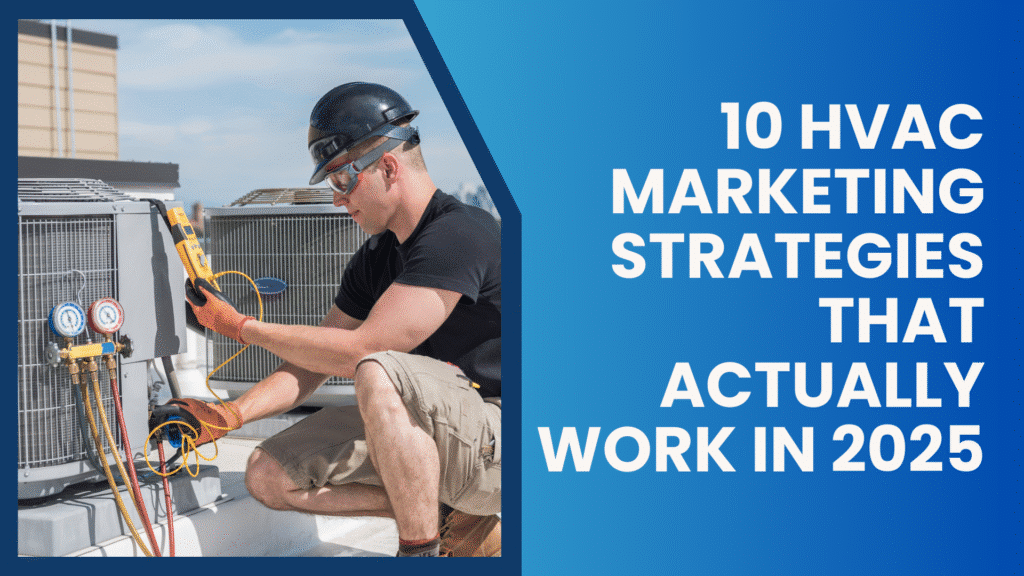
Did you know 91% of homeowners go online before hiring an HVAC company? If your business isn’t showing up, those leads go to your competitors. In 2025, rising ad costs, higher customer expectations, and more competition make it more complicated than ever to stand out.
Homeowners want quick answers, visible trust, and proof you’ll deliver, before they even call. Guesswork marketing won’t cut it anymore. You need strategies tailored for today’s market that save money and generate real jobs.
This blog shares 10 HVAC marketing tactics that will keep your business visible, competitive, and profitable.
Why HVAC Marketing Matters More Than Ever
A decade ago, homeowners might have asked neighbors for recommendations or flipped through a phone book. Today, nearly every HVAC purchase decision starts with a smartphone search.
The HVAC industry is projected to reach $390 billion globally by 2029, resulting in increased competition among contractors for the same leads. As ad costs surge across Google, LSAs, and social media, the only way to avoid wasted dollars is by tracking ROI carefully and optimizing what works.
Homeowners’ expectations have also changed. They now demand:
- Mobile-first websites that load quickly and allow instant booking
- Real-time communication, like appointment confirmations and technician arrival alerts
- Plenty of positive reviews before they’ll even consider making a call
In short, effective marketing in 2025 is no longer optional; it’s the difference between staying visible and being left behind. But even with these new opportunities, many contractors still fall into costly traps. Here are the most common mistakes to watch for:

Avoiding these common mistakes can make as much of an impact as running new campaigns. Now, let’s dive into 10 strategies that will help you book more jobs and protect your profits.
1. Set Google Business Profile (GBP)
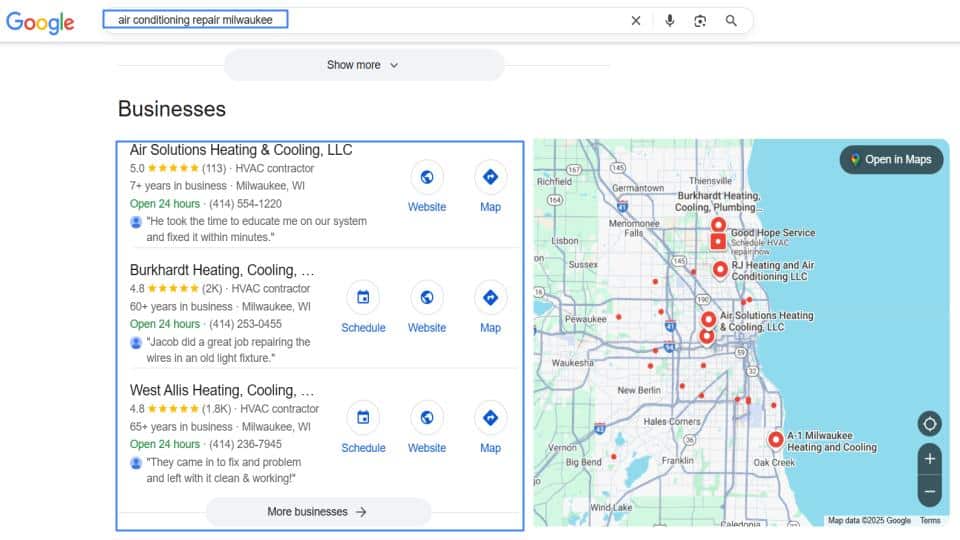
For most HVAC companies, the Google Business Profile is the most important marketing asset. It directly determines whether you appear in Google’s local “map pack,” the top three results that most homeowners click when searching for services like “AC repair near me.”
To maximize your GBP:
- Complete every detail (hours, phone number, website, service categories).
- Upload current photos of your team and recent jobs.
- Consistently collect reviews and respond to each one promptly.
- Use posts to share seasonal offers and updates.
Your Google Business Profile is often the first impression customers get of your business. A complete and engaging profile builds trust, while an outdated or neglected one sends them straight to competitors.
2. Social Media Matters
Visibility gets you found, but familiarity wins the call. Social media platforms like Facebook, Instagram, and even YouTube help you connect with homeowners in authentic ways.
What works best:
- Quick HVAC tips (“How often should you change your filter?”).
- Before-and-after installation photos.
- Behind-the-scenes snapshots of your team.
- Customer success stories and testimonials.
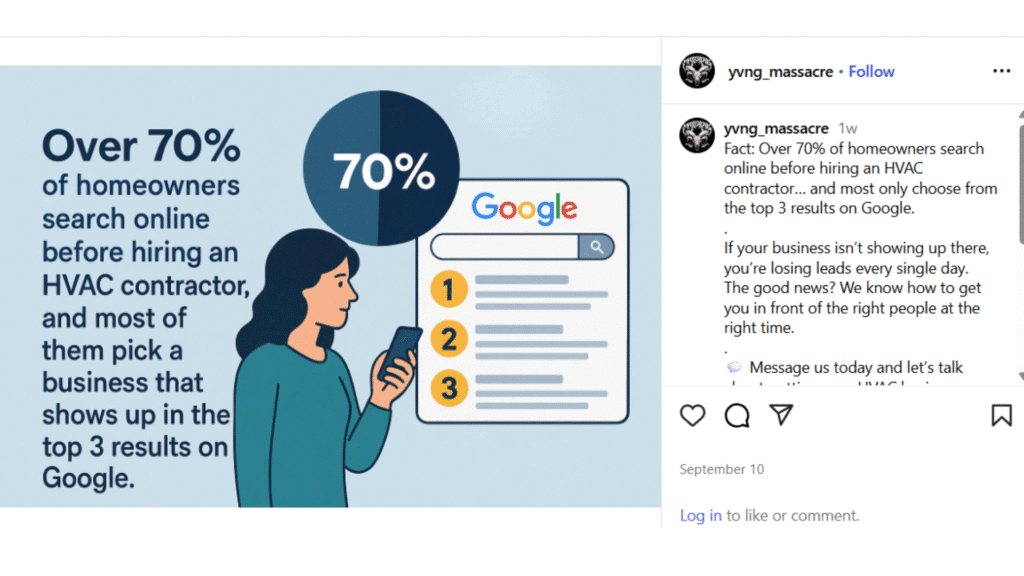
Among social platforms, Instagram is powerful because HVAC is visual.
Successful contractors use Instagram to:
- Post reels with short tips (e.g., “3 signs your furnace needs repair”).
- Share job-site transformations in before-and-after posts.
- Highlight technicians in Stories to humanize the brand.
Optimization is key: add location tags and hashtags like #HVAClife or #[City]HVAC to expand reach. With steady posting, Instagram builds both brand awareness and leads.
3. Email Advertising
Email remains one of the highest-ROI marketing tools for HVAC businesses. It’s direct, affordable, and easy to personalize.
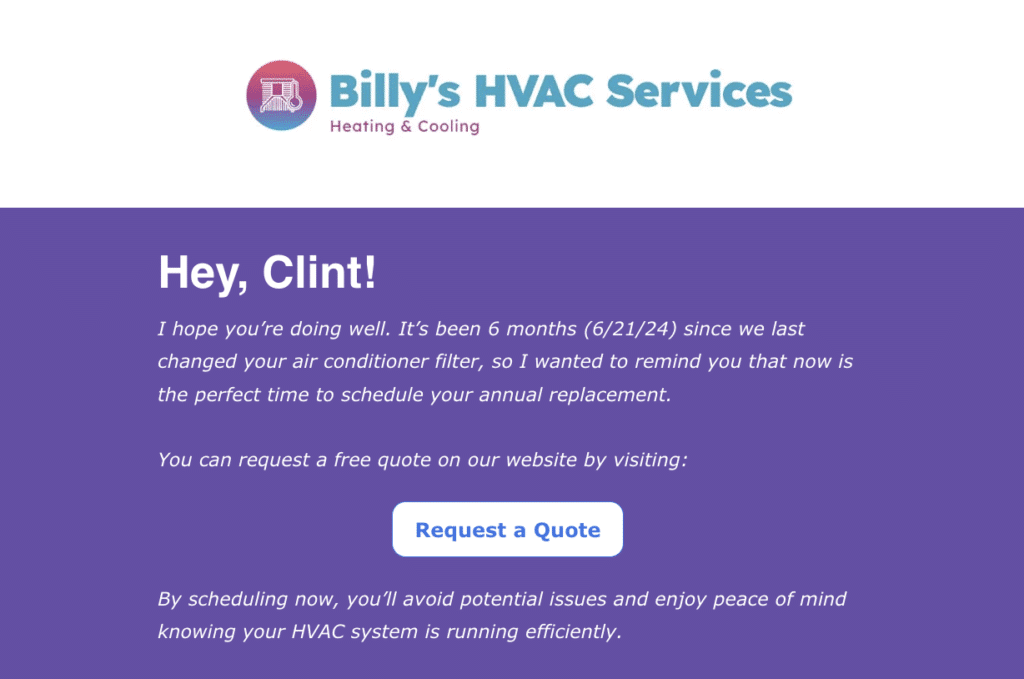
Examples of effective campaigns:
- Maintenance reminders: “It’s time for your spring AC tune-up—book now.”
Estimate follow-ups: “Still considering replacement? Save $250 if you book this month.” - Seasonal promotions: “Winter is here—don’t risk a breakdown, schedule your furnace service today.”
With automation, these campaigns run in the background. That means your marketing doesn’t stop just because the phone slows down. In 2025, combining email with SMS makes reminders even harder to miss.
4. Build a Better HVAC Website
Your website is the hub of your digital marketing. Even if a customer finds you on Google or social media, they’ll almost always visit your site before booking.
A strong HVAC website should:
- Have clear service pages for every offering.
- Display trust signals, such as licenses, warranties, financing options, and customer reviews, to establish credibility and build trust.
- Include online booking forms and live chat.
- Load quickly and run securely (HTTPS).
Think of your website as your 24/7 salesperson. Its job is to take traffic from every other channel and convert it into booked calls.
5. Develop a Mobile-Friendly Website
Mobile optimization is now a critical factor in both user experience and search engine performance. With the majority of HVAC searches happening on smartphones, having a responsive design that adapts to any screen size is essential.
Page speed is equally important, as sites that load in under three seconds see significantly lower bounce rates and higher conversion rates.
To maximize usability and encourage immediate engagement, your site should include:
- Click-to-call functionality so visitors can connect with you instantly
- Simplified booking forms that make scheduling effortless
- Embedded Google Maps for quick access to directions
From an SEO perspective, Google’s mobile-first indexing means mobile performance directly influences rankings. This makes mobile usability not just a best practice but a competitive necessity for achieving visibility and generating leads online.
6. Run a Paid Ad Campaign
Organic visibility takes time. Paid ads deliver immediate leads.
Here’s how the main options compare:
| Ad Type | Cost Model | Strength |
| Google LSAs | Pay-per-lead | Prime placement + Google Guaranteed badge |
| Google PPC | Pay-per-click | Flexible keyword targeting |
| Facebook/Instagram Ads | Paid impressions | Hyper-local audience targeting |
But here’s the real secret: don’t fly blind. Many HVAC businesses waste thousands of dollars because they don’t track their results.
Use tools like CallRail or ServiceTitan to see precisely which ads generated calls, how many turned into bookings, and what your true cost-per-lead is.
Once you know that, the strategy becomes simple: double down on the campaigns that deliver profit and cut the ones that don’t.
7. Local SEO Strategies
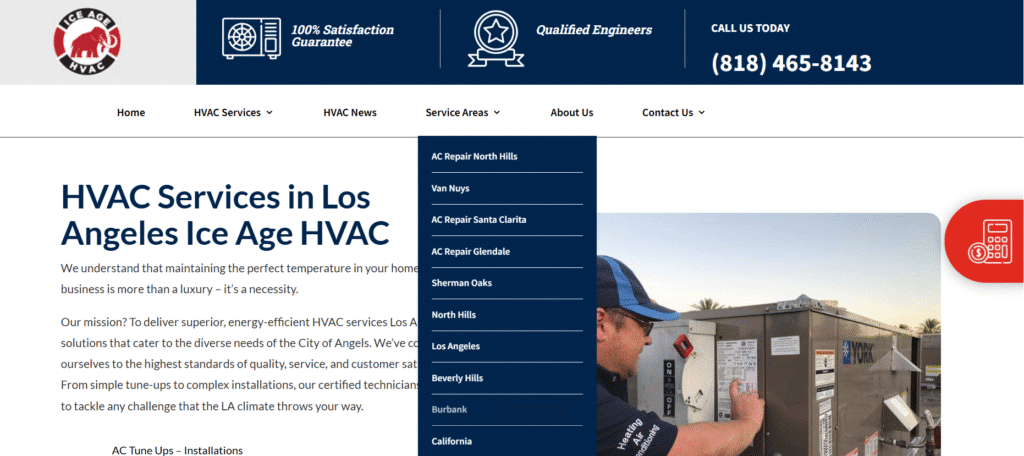
Paid ads drive leads fast, but when the budget stops, so do the calls. Local SEO is what keeps your business visible month after month, without requiring you to pay for every click. Think of it as building digital real estate in your service area.
That means:
- Dedicated service pages for each city or neighborhood you serve
- Localized keywords (“AC installation in Plano”) to rank where it matters
- Content that answers local questions and establishes you as the go-to expert
- Consistent directory listings + embedded Google Maps so customers always find you
- Schema markup and steady reviews that boost both visibility and credibility
By combining paid ads and local SEO, you create a pipeline that delivers immediate leads now and sustainable growth for the future. It’s not either-or; the most successful HVAC companies win by doing both.
8. Drive Conversions with Videos
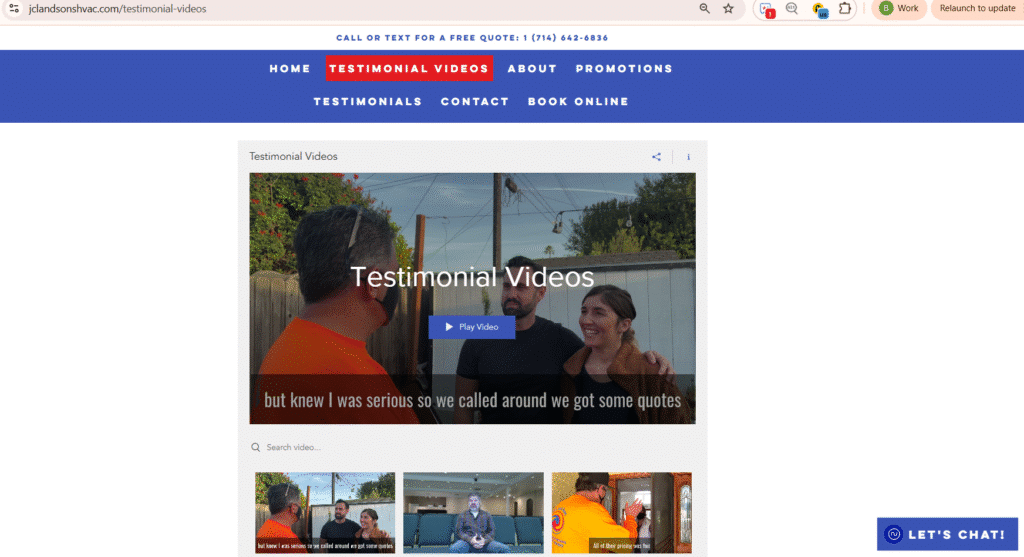
Video has become one of the fastest-growing marketing strategies for the HVAC industry. It builds trust by letting homeowners see your face, hear your expertise, and feel your credibility.
High-performing video types include:
- Explainers answering common questions (“Why is my AC blowing warm air?”).
- Technician introductions
- Seasonal maintenance walkthroughs
- Customer testimonial videos
Repurpose content across YouTube, your website, social media, and even email newsletters. You don’t need a Hollywood-level production; instead, authentic and helpful videos often perform best.
9. Customer Experience as Marketing
Many contractors believe marketing stops once the lead is booked, but the truth is that your customer experience is one of your most powerful marketing tools.

Every interaction, from the first phone call to the final repair, determines whether that customer leaves a glowing review, refers friends, or calls you again the next time.
What sets top HVAC companies apart is consistency in the details:
- Appointment confirmations and arrival texts build trust and reduce no-shows.
- Well-trained CSRs with proven scripts ensure more calls turn into booked jobs.
- Technicians who explain repairs clearly and respect the home leave customers feeling valued, not just serviced.
Ultimately, a seamless and respectful experience is often what earns a 5-star review, sometimes even more than the repair itself. And those reviews, referrals, and repeat calls? That’s free marketing you can’t afford to ignore.
10. Referral & Loyalty Programs
Word-of-mouth has always been the backbone of HVAC growth, and in 2025, the most competent contractors are turning it into a repeatable system. Instead of waiting for referrals to “just happen,” give customers a reason to spread the word and stay loyal.
Some proven approaches include:
- Referral rewards: Offer a gift card or service discount for every customer who refers a friend.
- Tiered promotions: Run a “refer three friends, get a free tune-up” campaign to spark momentum.
- Loyalty perks: Keep past customers engaged with complimentary filters, priority scheduling, or seasonal check-ups.
These programs cost significantly less than paid ads and deliver highly qualified leads because they establish trust. Additionally, loyalty perks reduce churn and keep your brand top-of-mind, turning one-time customers into long-term advocates.
FAQs About HVAC Marketing in 2025
1. When is the best time to launch HVAC marketing campaigns?
Plan ahead of peak seasons. Running promotions in spring and fall helps build awareness and bookings before the summer and winter rushes, thereby smoothing demand and stabilizing cash flow.
2. How can HVAC contractors track if marketing is working?
Use call tracking, CRM data, and job booking reports. Metrics such as cost per lead, conversion rate, and repeat customers indicate whether campaigns are truly driving revenue, not just clicks.
3. How long does it take to see results from HVAC marketing?
Paid ads can deliver leads within days, while SEO and content strategies typically take 3–6 months. The most effective plans utilize both short-term and long-term strategies simultaneously.
4. Will HVAC maintenance costs increase with new systems?
Maintenance costs may shift slightly with the introduction of new refrigerants, as technicians will need updated certifications and tools. However, because the new systems are built with greater efficiency and reliability in mind, you may see fewer breakdowns and lower repair costs over the system’s lifespan.
5. How will the HVAC industry change in 2025?
Starting in 2025, the HVAC industry is expected to undergo a significant shift toward using low-GWP (Global Warming Potential) refrigerants to comply with new environmental regulations. Two of the most talked-about replacements are R-32 and R-454B, both designed to reduce environmental impact while maintaining efficiency.
6. How much is HVAC equipment going up in 2025?
Homeowners should expect HVAC equipment prices to rise by 20–25% in 2025. The adoption of new refrigerant technology drives this increase, along with the use of updated materials and stricter compliance standards.
Final Takeaway
Growing an HVAC business in 2025 comes down to clever, consistent marketing. Homeowners expect fast responses, easy booking, and proof they can trust you before making a call.
By using the right mix of digital tools, like Google profiles, local SEO, ads, and video, you stay visible and convert more searches into booked jobs. Pair that with great customer experiences and referral programs, and you create lasting growth.
Focus on strategies that deliver real results, and you’ll stay ahead of competitors all year.


